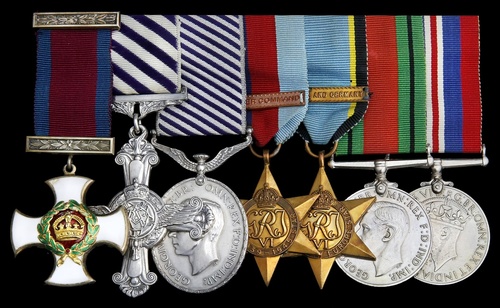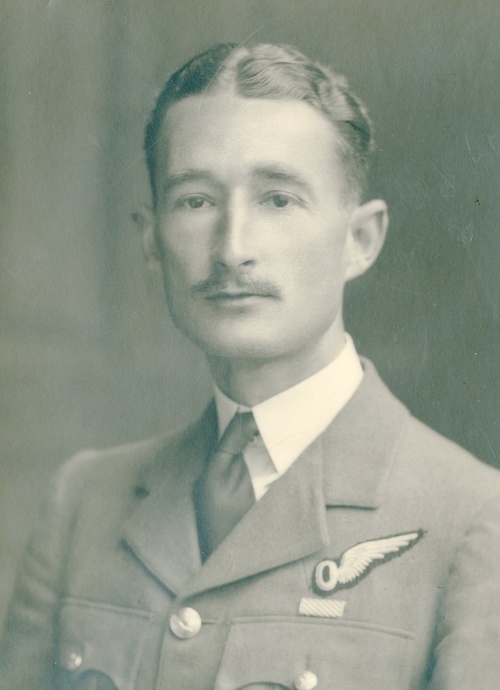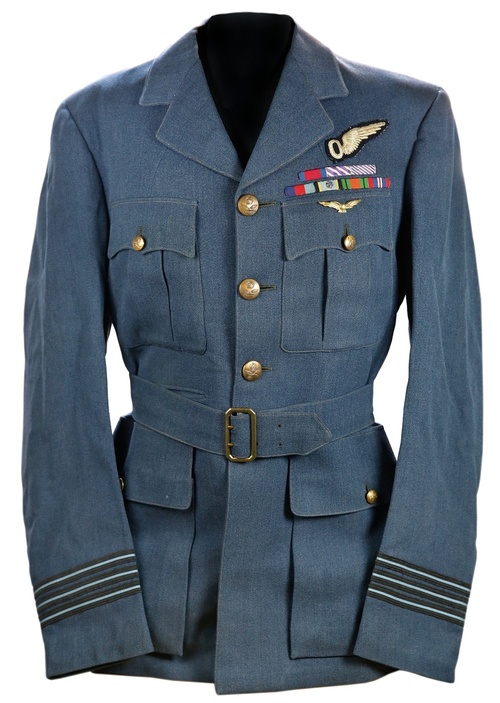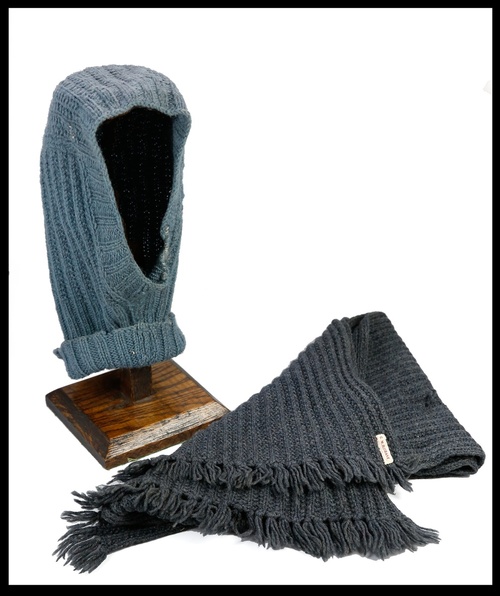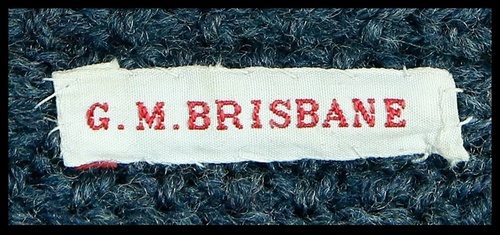Auction: 17003 - Orders, Decorations and Medals
Lot: 718
Sold by Order of a Direct Descendant
'He had first come to notice for his gallant efforts in 1941, during a perilous daylight attack on the German battle cruiser 'Scharnhorst', which lay at La Pallice after having undergone a refit at Brest.
As navigator and bomb-aimer of the leading aircraft of a formation of 15 heavy bombers - of which five were shot down - Brisbane brought his pilot to the target at the French Atlantic coast port within a minute of the estimated time of arrival.
During the run-up his aircraft was repeatedly hit by flak, but, according to his D.F.C. citation, he directed the attack with 'unhurried calm and meticulous care, and carried on with the run until photographs of the results were complete … The bombing procedure was carried out exactly as on a practice range.'
Brisbane scored three direct hits on the battle cruiser. One bomb damaged the steering gear but two failed to explode … '
The Daily Telegraph's obituary notice for Wing Commander Guy Brisbane, D.S.O., D.F.C., D.F.M., refers.
The exceptional Second World War Bomber Command D.S.O., D.F.C., D.F.M. group of six awarded to Wing Commander G. M. Brisbane, Royal Air Force
In recognition of his superb record as a navigator and bomb-aimer he held temporary command of No. 10 Squadron in 1943-44. It was a highly unusual appointment for one bereft of 'Wings' but not perhaps as unusual as his gallantry awards: just 14 members of aircrew were likewise honoured in the last war
A veteran of two tours of duty - amounting to more than 60 sorties and 300 hours of operational flying - Brisbane's gallant record encompassed much flak damage and membership of the Caterpillar Club
Distinguished Service Order, G.VI.R., the reverse of the suspension bar officially dated '1944'; Distinguished Flying Cross, G.VI.R., the reverse officially dated '1941'; Distinguished Flying Medal, G.VI.R. (515083 Sgt. G. M. Brisbane, R.A.F.); 1939-45 Star; Air Crew Europe Star, clasp, France and Germany; War Medal 1939-45, mounted as worn, together with Royal Tournament prize medals (2), silver, the reverse engraved, '1934 Bayonet Team Combats, Royal Air Force, First Prize, R.A.F. Cranwell, A.C. 2 G. Brisbane', another similar, bronze, the reverse engraved, 'R.A.F. Coastal Area, Bayt. Team Combats, Cranwell, A.C. 2 Brisbane, G., 1934', one obverse arm of the D.S.O. with chipped enamel, otherwise very fine or better (6)
D.S.O. London Gazette 22 September 1944. The original recommendation for an immediate award states:
'Acting Squadron Leader Brisbane was posted to No. 10 Squadron in October 1943, having already completed one operational tour of 31 sorties, comprising 228 operational hours.
During his second tour he has taken part in a large number of sorties against a wide range of strongly defended targets. These have included: Hanover, Frankfurt, Essen, Bremen, Dusseldorf, Kiel, Duisberg and Munster.
This officer has commanded a flight since his arrival, and has displayed a marked capacity for leadership. His energy and drive, coupled with his tactical ability, have helped raise the morale of the Squadron to a high level, and have made a notable contribution to the unit's operational efficiency. When called upon to deputise for the Squadron Commander he has proved to be an able administrator.
Acting Squadron Leader Brisbane's record is one of outstanding merit. I strongly recommend that his admirable work and unfailing devotion to duty be recognised by the immediate award of the Distinguished Service Order.'
D.F.C. London Gazette 2 September 1941:
'The KING has been graciously pleased to approve the following awards in recognition of
gallantry displayed in flying operations against the enemy:
In July 1941, large-scale attacks were made on German warships at Brest and La Pallice (including the "Gneisenau", "Scharnhorst" and "Prinz Eugen"). A smaller attack was made on Cherbourg. The operations were carried out in daylight and extremely heavy and accurate anti-aircraft fire and fighter opposition were encountered by all aircraft when approaching the targets, which at Brest was protected by a balloon barrage. The air crews engaged succeeded, nevertheless, in securing direct hits on their objectives and in inflicting very severe damage in the target area. During the combats with enemy fighters 21 hostile aircraft were destroyed and others were severely damaged. The precise timing of attack by the various formations of aircraft and their correct approach to and accurate bombing of the objectives in the face of such powerful opposition; demanded great skill and high courage. The great success of these operations was largely due to the bravery, determination and resource displayed by the following officers and airmen, who participated in various capacities as leaders and members of the aircraft crews … '
The original recommendation for an immediate awards states:
'Flying Officer Brisbane was Navigator and Bomb Aimer in the leading aircraft of a formation of Halifaxes which made a daylight attack on the "Scharnhorst" at La Pallice on 24 July 1941.
This officer had spent most of the previous night and the morning in perfecting navigation arrangements, and brought the section to the target within one minute of the estimated time.
During the run-up to the target the aircraft was repeatedly hit by flak, but despite this, he directed the section with unhurried calm and meticulous care, and carried on the run until photographs of the results were complete.
The success of the sortie was to a great extent due to his coolness and precision and his unhurried directions were a fine inspiration and example to his crew.
I strongly recommend that his fine effort be recognised by the immediate award of the D.F.C.'
D.F.M. London Gazette 22 October 1940. The original recommendation states:
'This N.C.O. Observer has contributed in a very large measure to many very excellent shows. He has always been a very good example to his juniors and has been of great assistance in passing on his operational knowledge to others.'
Covering remarks of the A.O.C., No. 4 Group:
'A keen and capable Observer who has now completed 29 operational flights over enemy territory. His determination and courage have been an example to others of his squadron. Strongly recommended for the award of the D.F.M.'
Guy Maxwell Brisbane was born in London in 1911 and was educated at Southgate Grammar School. His father, a member of a City cotton-broking firm, found young Guy a job selling leather goods, but after a few years, he left to enlist in the Royal Air Force.
Because of astigmatism in one eye he was unable to undertake pilot training but qualified instead as an Air Observer in June 1939. On the outbreak of hostilities and having been advanced to Sergeant, he was serving in No. 104 Squadron, a Blenheim unit based at R.A.F. Bicester. A few weeks later, however, he transferred to No. 51 Squadron, a Whitley unit.
No. 51 Squadron - D.F.M. - election to the membership of the Caterpillar Club
Having then qualified in Astro Navigation at St. Athan in March 1940, he flew his first sortie with No. 51 on 11 April, an anti-shipping mission to Norway. Later in the same month he and his crew attacked Stavanger.
On 2 May, with Squadron Leader Marvin at the helm, they attacked an enemy airfield in Norway but, owing to fuel shortage, skipper and crew were forced to abandon their Whitley by parachute. After the war, Brisbane submitted a secret report on R.A.F. training, in which he quotes this incident in respect of parachute usage:
'On one occasion in early 1940, I had to abandon a Whitley aircraft by parachute, due to petrol shortage and bad weather over England. Nobody in the crew had jumped before. We had all heard the correct method of abandoning an aircraft was to dive out head first. Apart from the extreme physical reluctance one felt towards leaving the aircraft head first, it was found - when the order came to jump - that it was practically a physical impossibility to leave the Whitley escape hatch in this fashion. I, being the first to jump, wasted a good deal of time trying to find the best way of getting out. I eventually found the only practicable way was to go through the hatch feet first, facing aft. The rest of the crew followed this example and we all left the aircraft safely. Unfortunately, one member of the crew landed so heavily that he died of his injuries … When this experience is considered it really is astounding that R.A.F. crews, who relied on parachutes, knew so little about the correct method of using them.'
Less than a fortnight later, Brisbane was back on operations, taking part in several bombing attacks on the Ruhr, in addition to a precision strike on a bridge on the Meuse. His flying log books notes shrapnel damage in a sortie to Essen in this period.
June 1940 witnessed Brisbane undertake no less than 13 operational sorties, around half of them against enemy troop concentrations and communications in France as the net closed round the B.E.F. His secret report on R.A.F. training quotes an incident that occurred over France in this period:
'I can remember being sent one night to attack troop concentrations during the German advance through France in 1940. The road junction we had been ordered to search for had been located by the aid of flares and enemy troops and transport columns were seen moving along the road. The pilot of my aircraft - in an excess of enthusiasm - made a low-level approach at about 1,000 feet and I in my excitement left the distributor switch on 'single and salvo' instead of 'distributor'. The result being that, when I released the bombs, the full load fell in a salvo instead of a stick. The bombs were instantaneously fused and when they burst 1,000 feet below us the resultant explosion was catastrophic. By good fortune no great damage was done to the aircraft and we were able to return to base.'
The remainder of his sorties were largely of the German kind, among them trips to Essen and Homberg in June and to Kiel and Wismar in July; his flying log book again notes flak damage over Kiel on the 8th - 'Very heavy A.A. fire. Shrapnel through fuselage tank and main planes.'
August's operational agenda included a strike on the Fiat works at Turin, whilst in September Brisbane attended another navigation course. He was awarded the D.F.M. and appointed the Squadron's Navigating Officer and Bombing Leader, and remained similarly employed until posted to No. 76 Squadron, a Halifax unit operating out of Middleton St. George, in June 1941.
No. 76 Squadron - immediate D.F.C.
Brisbane flew his first sortie - against Kiel - on the night of 24-25 June 1941 and thereafter flew as Navigator to Wing Commander G. T. Jarman, D.F.C. In the following month they attacked Bremen on the night of the 3rd-4th but, as cited above, it was for his part in the attack on the Scharnhorst at La Pallice on the 24th that Brisbane won his immediate D.F.C.:
'During the run-up to the target the aircraft was repeatedly hit by flak, but despite this, he directed the section with unhurried calm and meticulous care, and carried on the run until photographs of the results were complete. The success of the sortie was to a great extent due to his coolness and precision and his unhurried directions were a fine inspiration and example to his crew.'
Brisbane was grounded for a 'rest' and posted to H.Q., Bomber Command.
No. 7 Squadron
In December 1942, he returned to operations with an appointment in No. 7 Squadron, a Stirling unit operating out of Oakington, and flew his first sortie - a strike on Turin - on the night of the 11th-12th.
He flew further strikes against Munster and Le Creusot in June, the same month in which he transferred to No. 10 Squadron, a Lancaster unit.
No. 10 Squadron - immediate D.S.O.
By now a Flight Commander with overall responsibility for 10's navigational skills, and sometimes deputising as Squadron C.O., Brisbane commenced a final flurry of operational activity.
One of his first targets was Hamburg, at the commencement of the famous 'firestorm' raids in late July 1943. Dusseldorf and Frankfurt were among the chosen targets in November, whilst in the new year he was detailed to attack Essen, prior to moving on to a number of French targets at the time of the Normandy landings.
As related in his obituary notice in the Daily Telegraph, on one occasion his pilot's oxygen supply failed over the Alps: Brisbane gave the pilot his own oxygen and blacked out - but not before providing a course home. He was awarded an immediate D.S.O.:
'This officer has commanded a flight since his arrival, and has displayed a marked capacity for leadership. His energy and drive, coupled with his tactical ability, have helped raise the morale of the Squadron to a high level, and have made a notable contribution to the unit's operational efficiency.'
Postscript
Brisbane ended the war as a staff officer with 222 Group in Ceylon and afterwards served as a weapons specialist.
From 1950 to 1953, he was attached to the U.S.A.F. as a senior weapons officer at Wright Field, Dayton, Ohio. Having then held staff appointments back in the U.K., he was placed on the Retired List as a Wing Commander in 1958 and settled in Norfolk.
Sold with a quantity of original documentation, including the recipient's D.S.O. warrant, in the name of 'Acting Squadron Leader G. M. Brisbane, D.F.C., D.F.M., Royal Air Force, No. 10 Squadron', dated 22 September 1944; his Caterpillar Club membership card, in the name of 'Sgt. G. M. Brisbane'; U.S.A.F. Certificate of Proficiency, in the name of 'Sqd. Ldr. Guy W. Brisbane, 44772, R.A.F.', dated 13 March 1953; Air Ministry retirement letter, dated 20 January 1958, one or two photographs, including wartime portrait in uniform; and a photocopied record taken from his flying log book, the original being held in the collection of the Imperial War Museum, together with a photocopy of the recipient's report on 'Operational Training in the R.A.F.', before and during the 1939-45 War, written in early 1947, 26pp.
Also to be sold with the recipient's woollen balaklava and scarf, as worn by him on operations in Whitleys at the beginning of war; and his R.A.F. uniform, comprising tunic, complete with rank insignia, Observer's brevet, medal ribands and his P.F.F. badge; trousers, shirt and peaked cap.
Subject to 20% VAT on Buyer’s Premium. For more information please view Terms and Conditions for Buyers.
Sold for
£10,000

